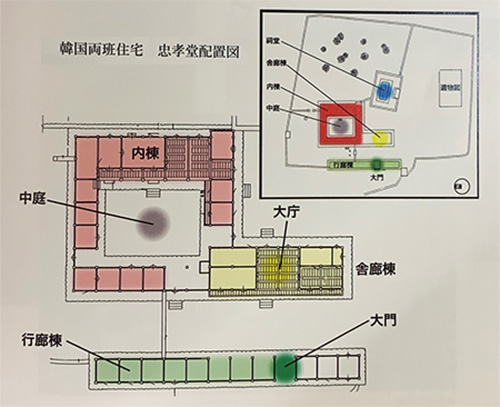

さてハフェマウル・柳氏一族の住建築探訪であります。
この「忠孝堂」は壬申倭乱と韓国で名付けられる1591年の秀吉の朝鮮出兵時に
宰相・柳成龍を輩出していたこの一族の本宅とされます。
ということでいきなり厳しい日韓関係史に向き合わされることになる。
柳成龍。(以下要旨引用 OhSongHo「韓国朝鮮歴史のトリビア」より)
〜彼は慶尚北道義城で生まれ子供の頃ソウルで李舜臣と親密に過ごした。
<李舜臣は今回のオリンピックで話題になった。>
その後河回村で過ごし頭脳明晰で学問師匠から高く評価されたそうです。
1564年司馬試に合格し1566年官職に上がり朝鮮国王・宣祖が即位した後、
重用され順調な官職コースを歩んだとされる。
彼の活動期は党争が始まった時期で巻き込まれたがさほど被害を受けなかった。
秀吉の朝鮮侵略を探る通信使の報告に際し戦争が起こるとは思わなかったとされる。
それでもやはり気まずかったのか李舜臣などを推薦・登用し
各地域の城塞の修築をするなど戦争の準備をしようと努力しては居ます。
領議政(宰相)として内政と軍事の両面を担う事になります。
その後隠遁生活をしながら「懲毖録」執筆活動に勤しみました。
懲毖録は韓国国宝で壬辰倭乱の貴重な記録とされる。1607年5月死去。〜
こういう経歴の人物であり明の冊封を受けている李氏朝鮮での国教といえる
儒教体制での指導者として名をはせた人物と言えるのでしょう。
日本では戦国末期に相当するいまから400年ほど前の時代を生きた人物。

この家の名前も「忠孝」といういかにも儒教的な命名。
典型的な上流「両班〜ヤンパン」住宅として日本の国立歴史民俗博物館資料でも
上のように間取り図が取り上げられています。
写真は大門から大庁方向を見るアングルと大庁のある舎廊棟をサイドから見た図。
大門というのは門の棟だけを一段高くして身分を表すとされる。
朝鮮では男性と女性で空間が仕分けされていて舎廊棟は男性空間。
板敷きの大庁の左右には床暖房のオンドル房が配置されている。
舎廊棟は基壇が高く、さらに高欄を設けるなど儒学者としての地位を表現している。
2枚目の写真の奥に、女性と子どもが暮らす生活空間。
いろいろな住宅についての歴史情報が飛び込んでくる。
同時期の日本は戦国の最終段階であり、利休の数寄屋茶室までが現れた時代。
一方の韓国では明の冊封体制下、儒教による秩序体制が深まっていった。
大航海時代の荒波は日本では強く感受されたけれど、
韓国朝鮮ではむしろ大陸中国の強い影響力が支配的だったとわかります。
ちなみに当時の人口規模は日本は1,300万人ほどで、朝鮮は1/4ほどとされる。
大陸国家社会との距離感がそのまま政治・文化に反映されているように思える。
茶の湯の機能に合わせた自由な建築がもてはやされた日本の時代感覚と
秩序意識がきわめて濃厚だった朝鮮の住宅建築の設計思想。
世界と繋がった海洋国家と、大陸国家との距離感に配慮する半島国家。
どうもそういったイメージが自然に起こってくる気がします。
あしたもこの忠孝堂、検証してみたい。
English version⬇
[Mr. Lee, the house of the “Chancellor” of Korea, Zhongxiao-do, Hahoe Village, South Korea -5]
By the way, it is a house architecture exploration of the Hafemaul Yanagi clan.
This “Tadatakado” was named the Yang Water Monkey in Korea when Hideyoshi sent troops to Korea in 1591.
It is the home of this clan that produced the Chancellor Ryu Seong-ryong.
As a result, we are suddenly faced with a harsh history of Japan-Korea relations.
Ryu Seong-ryong. (From OhSongHo “Trivia of Korean History” )
~ He was born in Yi Castle, Gyeongsangbuk-do, and spent his childhood intimately with Yi Sun-sin in Seoul.
.
After that, he spent time in Andong Hahoe Village and was highly praised by his academic master for his clarity.
After passing the Shiba test in 1564 and rising to the official position in 1566, the King of Korea and Seonjo of Joseon took the throne.
He is said to have been heavily used and went through a successful official course.
His period of activity was involved at the beginning of the party dispute, but was not significantly damaged.
He allegedly did not expect a war to occur when Hideyoshi reported a messenger exploring the invasion of Korea.
Was it still awkward? He recommended and promoted Yi Sun-sin and others.
He is trying to prepare for the war, such as repairing the citadels in each area.
As a congressional government (Chancellor), he will be responsible for both domestic affairs and military affairs.
After that, he lived in seclusion and worked on writing “The Jingbiro”.
The Jingbirokku is a national treasure of Korea and is regarded as a valuable record of the Yang Water Dragon. Died May 1607. ~
It can be said that Mr. Lee, who is a person with such a background and has received the Ming dynasty, is the state religion in Korea.
It can be said that he is a well-known person as a leader in the Confucian system.
In Japan, a person who lived in the era about 400 years ago, which corresponds to the end of the Warring States period.
The name of this house is also “Tadataka”, which is a very Confucian name.
As a typical upstream “Rangoban-Yangban” house, even in the materials of the National Museum of Japanese History and Folklore in Japan
The floor plan is taken up as above.
The photo is a side view of the Sarangbang building where the Daimon is located and the angle from the Daimon to the Daimon.
Daimon is said to represent the identity by raising only the ridge of the gate.
In Korea, the space is divided into men and women, and the Sarangbang is a men’s space.
Ondol bunches for floor heating are located on the left and right sides of the wooden boarding office.
The Sarangbang has a high base and has a high section to express its position as a Confucian scholar.
In the back of the second photo is a living space where women and children live.
Historical information about various houses pops in.
At the same time, Japan was in the final stage of the Warring States period, when Rikyu’s Sukiya teahouse appeared.
On the other hand, in South Korea, the Confucian order system deepened under the Ming dynasty book-sealing system.
The rough waves of the Age of Discovery were strongly felt in Japan,
It turns out that in South Korea, the strong influence of mainland China was rather dominant.
By the way, the population size at that time was about 13 million in Japan and about 1/4 in Korea.
It seems that the sense of distance from the continental national society is directly reflected in politics and culture.
With the sense of the Japanese era, where free architecture that matches the function of the tea ceremony was touted
The design concept of Korean residential architecture, which was extremely conscious of order.
A peninsula nation that considers the sense of distance between a maritime nation connected to the world and a continental nation.
I feel that such an image naturally occurs.
I want to verify this Tadatakado tomorrow.
Posted on 8月 23rd, 2021 by 三木 奎吾
Filed under: 住宅マーケティング, 日本社会・文化研究







コメントを投稿
「※誹謗中傷や、悪意のある書き込み、営利目的などのコメントを防ぐために、投稿された全てのコメントは一時的に保留されますのでご了承ください。」
You must be logged in to post a comment.